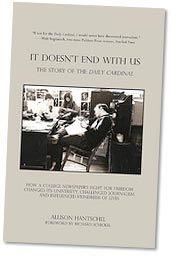New book explores Daily Cardinal’s legacy
After a decade of newspaper reporting, University of Wisconsin–Madison journalism graduate Allison Hantschel found that the most interesting story she was ever a part of was the one she experienced herself during her years on the Daily Cardinal staff.

It is the stories of the students, the fights and the successes of the Cardinal that lent her subject material for her new book It Doesn’t End With Us, about the legacy of the Daily Cardinal at UW–Madison.
"The Cardinal legacy is really two-fold. It lies in the journalism, like the ground-breaking stories," Hantschel says. "It also lies in the journalists. The Cardinal is an educational system. The work never really stops; it ripples out from the Cardinal and affects ordinary people."
"It Doesn’t End With Us" gives readers not just a glimpse into the inner workings of one of the nation’s oldest daily student papers, but a detailed description of the past 115 years of struggle by students to keep UW–Madison’s Daily Cardinal afloat as an independent entity.
When William Wesley Young founded the Cardinal in 1882, only 72 students gathered in Science Hall to vote for the birth of the Cardinal and Young as its editor. Few expected the sixth daily student newspaper in the nation to survive independently without school support.
But by the 1920s and 1930s, the newspaper was already becoming a famous "radical" student paper, calling prohibition "an injustice to youth" and publishing letters favoring "free love."
During World War II, when many student newspapers shut down, the Cardinal continued publishing, run by an all-female staff of only six students. The radical traditions continued through the 1950s and 1960s when the Cardinal denounced McCarthyism, championed civil and women’s rights, and railed against the Vietnam War.
In 1970, the paper faced one of its most difficult challenges when two of its staffers were involved in the bombing of an army research lab on campus and the subsequent death of a researcher. The CIA investigated the paper for communist sympathies.
During the 1980s, the paper faced a takeover from rival the Badger Herald and the shutting down of its printing press.
But their darkest hour came in 1995 just after Hantschel had just finished her brief stint as editor in chief. Faced with $137,700 worth of debt, the Cardinal was forced to shut down for seven months before it could re-negotiate with advertisers and printers.
The night before the first edition after the shutdown was to set to run, all the staff was lying down the spread on the floor, pasting the layout in a specific order when the graphics editor realized the copy was laid down backward.
"It was like a crazy ballet of paper and glue, people shouting, and at that point, you’re laughing just because screaming makes the headache worse. Everybody was copy editing that night, including some guy I’d never seen before," Hantschel recalls.
"He was the delivery guy, pressed into service. That’s the kind of atmosphere it was. It was all very ad hoc, totally and absurdly goal-oriented — we’re gonna do this however we have to do it to get it done and worry about what is whose job tomorrow."
More than a decade later, the Cardinal still has this crazy atmosphere and motivated staff.
As current Cardinal editor Jill Klosterman says, the proof of the Cardinal success is in its people.
"The people are the legacy. Everyone there is gritty and self-sufficient," Klosterman says. "Nobody is going to hold your hand. You have to just keep going."
Hantschel currently works for the Ernest Hemingway Foundation of Oak Park. She also operates a politics and journalism blog called First Draft.
Tags: journalism, learning, student life

